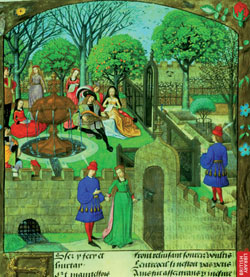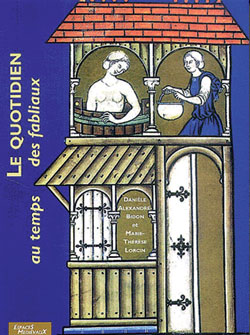‘Fabliaux’,
farces and morality tales
 The term “Fabliau” denotes a medieval literary genre: a short, tale
in verse with stock characters, realistic details, sexual
transgressions, obscenity, and a clever plot mocking human weaknesses
and making cynical fun of conventional notions of morality, authority,
and poetic justice. The term “Fabliau” denotes a medieval literary genre: a short, tale
in verse with stock characters, realistic details, sexual
transgressions, obscenity, and a clever plot mocking human weaknesses
and making cynical fun of conventional notions of morality, authority,
and poetic justice.
Deriving from the medieval French dialect word flabel or fablel,
“fabliaux” combine an original generic combination of the farce and the
dirty story. In the fabliau the “givens” are infidelity, opportunism,
trickery, and gullibility.
Considering their shocking and subversive content, these fables were
surprisingly popular in medieval France, especially between the
mid-twelfth and mid-fourteenth centuries.

Most were anonymous, probably composed by wandering minstrels,
usually termed jongleurs . Of the great number originally current, only
about 150 survive. Although the content is obviously low, there is still
academic dispute about whether the intended audience was bourgeois.
Their influence was naturally strongest in France, but there is an
anonymous Middle English fabliau, Dame Sirith , written in the late
thirteenth century.
Furthermore, elements of the fabliau are powerfully apparent in
certain works of Chaucer, Boccaccio, Shakespeare, and Chaucer’s
narrative compendium, the Canterbury Tales (1386–1400). Most concern
adulterous triangles, usually arising out of doting husbands who have
foolishly acquired sly, materialistic, and sexually adventurous wives.
Feminine agency
Medieval feminine agency is revealed often through a tertiary type—a
woman who appears at the margins and between the boundaries. She is
found in a number of Medieval genres and is often characterized as
intelligent, striking, resourceful and capable. She appears, at least
for a time, in male garb as a disguise.
Whether she emerges from an obscene and humorous fabliau, an
uplifting and noble roman, or even from a religious tale of a saint’s
life, she can be seen as willfully utilizing her skills and gifts to
overcome hardships, abuses of power, and social restraints and
proscriptions, all while achieving specific changes which can be viewed
from within the medieval literary and social context as just outcomes.
It is fascinating that in such a variety of medieval French literary
genres, there are so many women wearing men’s clothes. Considering the
pervasive influence of the Church at the time, and the prevailing
misogynistic attitudes toward women, it is surprising to find so many
heroines subverting or flouting gender roles in both dress and behaviour.

However, transvestism in theses tales provided women with
opportunities to exercise social and psychological agency and mobility.
It also served to reinforce medieval gender roles by emphasizing that
the resourceful female must adopt male characteristics in order to
realize her goals.
However, the cross-dressed woman is able to determine her own actions
while the more typical romantic heroine is still subject to conventional
hierarchical limitation. She is idealized, frail, ornamental, and in
need of rescue.
Cross-dressing and representations of female agency and feminine
intelligence in medieval texts also reveal underlying tensions about
sexuality, particularly as they are depicted in fabliaux settings.
Cross-dressing women often seek redress from a world of
oppression, abuses of power, and deception.
Honour
These tales also reveal a sort of trickery, which, when morally
employed in a quest for the restoration of honor, virtue, or good, lauds
the abilities of weaker elements of society.
As these characters negotiated the difficulties of their time, their
strategies and successful outcomes, while often funny and entertaining,
also served to encourage a good-natured and encouraging sense of social
worth and solidarity among similarly vulnerable listeners.
Women, as marginalized beings, have often been required to resort to
trickery. This is not only to realize some modicum of independence but
simply to survive the difficulties facing them. Their female wiles
emerge directly from independent thought, deception, curiosity and
resourcefulness.
Of all the Medieval French genres, the fabliaux are the best examples
of stories falling into the larger category of Trickster folktales.
Fabliaux share characteristics with their heroes or heroine; they are a
literature of the marginal. Fabliaux are seemingly foolish tales which
set reality upon its end, and they expose the absurdity and frailty of
the social traditions they mock.
Like the tricksters who so often occupy a central role in these
fabliaux, these tales are often vulgar, utilizing language in ways both
shocking and yet clever and effective;they often carry an explicit moral
message.
The fabliaux also resemble trickster tales in that they mimic
authority, satirizing and parodying the serious. Fabliaux tricksters set
themselves (and their genre) up against the courtly, the genteel, and
the privileged, and in the process, as often as not, they are also
setting themselves up for an illustrative fall.
Manuscript
In the medieval French world, tales such as the fabliau did not occur
in a vacuum. They were combined with other genres both in terms of how
they were transcribed and compiled in manuscripts, and in the ways that
they were told.
An evening’s entertainment could very well see a fabliau intermingled
with other more “lofty”, courtly tales, less scatological fables, and
poetry or songs. Among these were romantic stories which would often
double up as morality tales.
In examining Old French literature of the Middle Ages, a significant
change occurs with the birth of the courtly narrative.
As medieval narrators become more complex and self reflective, and as
they begin to explore underlying psychological motives, there is a
concomitant flowering of the idealized courtly lady—constructed both in
the medieval and often in modern literary criticism, as an archetypal
representative of the pure and perfect woman.
These remote ‘courtly ladies’ are held up as the standard against
which more ‘earthy’ feminine types, such as peasant girls and the
fabliaux women, who are compared and found wanting.
These women are often viewed as parodies of more ideal and romantic
type and the characters and genres are juxtaposed. It would be easy to
assume that since these characters occupy opposing categories. Their
traits would naturally be similarly conflicting.
In this view, less elevated tales such as the fabliaux provide
opportunities for feminine characters to possess active wit, cunning,
and cleverness while the romantic and idealized heroines of the courtly
literature are not characterized in this way.
Instead, they demonstrate passivity, nobility, purity, and beauty.
Some of the most popular romances of the 13th and 14th centuries are La
Chastelaine de Vergy, The Lancelot-Grail, Gui de Warewic, Roman de la
Rose ("Romance of the Rose"), Guillaume de Lorris (around 1225-1237) and
Jean de Meun (1266–1277).
Roman de la Rose and related poetry
The most significant of 13th century romances is the Roman de la Rose
which breaks considerably from the conventions of the chivalric
adventure story. In a dream a lover comes upon a garden and meets
various allegorical figures.
The second part of the work (written by Jean de Meun) expands on the
initial material with scientific and mythological discussions. The novel
would have an enormous impact on French literature up to the
Renaissance.
Related to this romance is the medieval narrative poem called "dit"
(literally "spoken", i.e. a poem not meant to be sung) which follows the
poetic form of the "roman" (octosyllabic rhymed couplets).
These first-person narrative works (which sometimes include inserted
lyric poems) often use allegorical dreams (songes), allegorical
characters, and the situation of the narrator-lover attempting to return
toward or satisfy his lady.
The 14th century poet Guillaume de Machaut is the most famous writers
of "dits"; another notable author of "dits" is Gautier le Leu. King René
I of Napless allegorical romance Cœur damour épris (celebrated for its
illustrations) is also a work in the same tradition.
La Châtelaine de Vergy
Another extremely well known French Medieval romantic novel with a
moral message is La Châtelaine de Vergy. Some critics believe that it is
a Roman à clé - a novel in which actual persons and events are disguised
as fictional characters.
It tells the story of an un-named knight in the service of the Duke
of Burgundy who is the lover of the Châtelaine of Vergy (the wife of a
châtelain and niece to the Duke). The Châtelaine, has accepted this
knight's love on one condition: that he must keep their relationship
secret from everyone, and he is able to visit his mistress when, by
their pre-arranged signal, she walks her dog alone in her garden.
When the Duchess of Burgundy falls in love with the knight, he is
forced to spurn her advances. In her anger, the duchess then tells her
husband that the knight is unfaithful and has tried to seduce her, and
the Duke accuses the knight of treachery.
To save his honour, and to avoid being exiled (and thus forced to
distance himself from his mistress), the knight (once the lord has
promised to keep his secret) reveals to his lord where his heart truly
lies, thus violating his promise to his mistress.
The Duke reveals the truth of the knight's love to his wife, and, at
the feast of Pentecoste, the Duchess makes a cruel inside joke to the
Châtelaine about her lover and her "well-trained dog".
The Châtelaine realizes her lover has not kept his promise and she
dies in despair. The knight discovers her body and kills himself. The
Duke finds both bodies, and exacts vengeance on his wife by killing her
with the knights sword, and then becomes a knight Templar.
The romance consists of 968 lines of verse in 8 syllable rhymed
couplets (the work is in the same poetic form as the majority of
medieval French romans, although significantly shorter than the romances
of Chrétien de Troyes whose work was discussed in the previous column).
The work has come down to us in 10 manuscripts. The oldest extant
version was written in 1288, and the presumed date for the composition
of the work is 1271-1288.
The depiction of love in the work is exemplary of the courtly love
tradition, with its emphasis on a relationship between a brave and
handsome knight and a married woman, and on secrecy and utter commitment
to a mistress rules. The Châtelaine de Vergy was apparently very popular
in courtly circles. |

